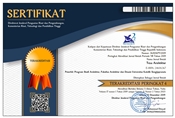Analisis Tatar Perilaku sebagai Langkah Awal untuk Membangun Desain Interior Sarana Pendidikan Anak Autis
Abstract
Keywords
Full Text:
PDFReferences
Ching, F. D.K. 1996. Ilustrasi Desain Interior. Jakarta: Airlangga.
Ghaziani, R. 2008. “Children’s voices: Raised issues for school design.” International Journal of Cocreation in Design and the Arts. 4 (4) 225 – 236.
Handojo, Y. 2003. Autisme: petunjuk praktis dan pedoman materi untuk mengajar anak normal, autis dan perilaku lain. Jakarta: PT. Bhuana Ilmu Populer.
Haryadi, B. S. 1996. Arsitektur Lingkungan dan Perilaku, Suatu Pengantar ke Teori,
Metodologi dan Aplikasi. Direktorat Jendral Pendidikan. Yogyakarta.
Jenkins, J. 2009. Designing learning spaces for children on the autism spectrum. University of Birmingham.
Laurens, J. M. 2004. Arsitektur dan Perilaku Manusia. Jakarta: PT Grasindo. 131.
Maulana, M. .2007. Mendidik anak autis dan gangguan mental lain menuju anak cerdas dan sehat. Yogyakarta: Kata Hati.
Peeters, T. 2004. Autisme. Jakarta: Dian Rakyat.
Pile, J. .2000. A history of interior design. 3rd ed. London: Laurence King.
Sommer, R., Sommer, B. (2001): A practical guide to behavioral research. New York: Oxford University Press.
Wildes, P, A. J. .2005. “Sensory stimulation and autistic children. Implications”. 6(4), 1–5.https://www.informedesign.org/_news/ apr_v06r-pr.pdf (diakses pada 8 Agustus 2018).
DOI: https://doi.org/10.24167/tesa.v18i1.1770
ISSN 1410-6094 (Print) | ISSN 2460-6367 (Media Online) | View My Stats

This work is licensed under a Creative Commons Attribution 4.0 International License.








